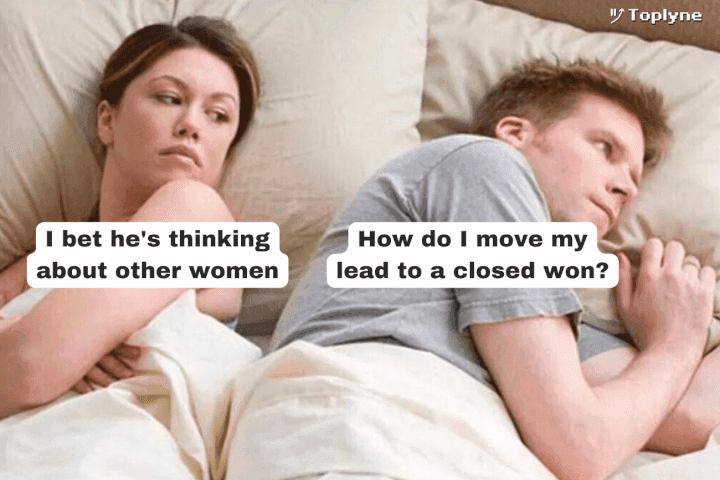The 7 Sales Lead Pipeline Stages Your Team Should Know
The 7 Sales Lead Pipeline Stages Your Team Should Know
The 7 Sales Lead Pipeline Stages Your Team Should Know
Explore the seven sales lead pipeline stages that your reps should know about. Also, discover a tool that can help you spot the hottest leads.
Explore the seven sales lead pipeline stages that your reps should know about. Also, discover a tool that can help you spot the hottest leads.
Explore the seven sales lead pipeline stages that your reps should know about. Also, discover a tool that can help you spot the hottest leads.



From the first contact to the closing call, a lot happens as your lead moves through the different stages of the sales pipeline.
Feeling nostalgic about your lead’s journey with you so far?

Time to go over what lead pipeline stages are!
In this article, we’ll discover what a sales lead pipeline is and how it differs from a sales funnel.
We’ll highlight the seven sales lead pipeline stages that are key to closing deals like a pro.
Finally, we’ll introduce you to an awesome tool that lets you build a pipeline of product qualified leads in no time.
Ready, set, sales!
What Is a Sales Lead Pipeline?
A sales lead pipeline or sales pipeline is a visual framework of the stages a lead moves through during the sales process. The further a prospect advances through the sales pipeline, the more likely that they’ll become your customer.
A sales pipeline helps companies:
Track every potential customer.
Allocate the best sales reps to bring the best leads across the finish line.
Assess the typical sales cycle length and much more.
As most sales teams work on multiple leads simultaneously, having all this information in one place can be a huge time-saver.
This way, your sales rep won’t have to open ten tabs or rifle through documents to get specific information about a deal or the sale pipeline stage it’s in.

Moreover, effective sales pipeline management enables you to:
Accelerate your sales cycle
Provide an accurate sales forecast
Boost sales performance
And while many use the terms sales pipeline and sales funnel interchangeably, your sales team shouldn’t be making that rookie mistake.
Sales Pipeline vs. Sales Funnel
Simply put, a sales pipeline indicates how far your prospect has come in the sales process, while a sales funnel shows where prospective customers are in the buying process.
The stages of a sales pipeline are more business-focused.
It involves understanding if a prospect is a right fit, deciding to meet a potential client over golf 🏌️or starting to prepare the proposal.
Whereas the stages of a sales funnel are more customer-centric — when they first heard of your product, downloaded the first eBook, or approached the sales rep.
Now, let's take a closer look at the seven sales pipeline stages and what goes on in each one.
Breaking Down the 7 Sales Lead Pipeline Stages
Most sales managers tend to organize their sales pipeline into the following seven stages:
1. Prospecting
What does prospecting have in common with those pre-credit scenes in your favorite series?
They both set the stage for real action! 🎬
Prospecting helps you connect with potential customers for your business.
It’s all about identifying individuals or businesses interested in what you’re selling.
Your sales representative tries to find leads that fit your ideal customer profile to improve your chances of closing the sale. Your marketing team also helps you capture every new lead through their lead generation campaigns on the website, social media, Google ads, and more.
To find the most potential buyer, your sales rep may target a specific industry, demographic, or location during the prospecting stage. Once done, the sales team compiles the contact details of every new lead so they can reach out to them in the future.
Pro tip: Consider using a sales CRM (Customer Relationship Management) software to organize all the data during the prospecting stage into manageable chunks.
2. Lead Qualification
In this sales pipeline stage, your team assesses the likelihood of a sales prospect becoming a customer.
Lead qualification helps sales managers determine if a prospect is a good fit to warrant discussing the next steps or if it's time to part ways.
For a prospect to qualify as a potential customer, they must have:
A requirement for your product
Show interest in your product
Been assessed by your team to ensure they are the right fit
Used your product and met certain daily active user criteria
The budget to buy your product
The authority to make the buying decision
Lead qualification helps channel all your energy and resources to only those qualified leads ready for that sales call. In fact, Toplyne can help you improve your meetings booked rates by only targeting highly interested leads with high product usage and engagement levels.
Bottomline —Lead qualification is one of the most important sales pipeline stages, preventing you from wasting time on dud leads.
3. Meeting or Demo
Once you’ve identified potential buyers from the previous sales pipeline stage, schedule a meeting or demo to introduce them to your offerings.
We know meeting a potential customer can be as nerve-wracking as ‘meeting the parents’, but it's also your one real opportunity to shine! 🌟
Go beyond marketing gimmicks to accurately highlight the USPs and benefits of your product while gauging the needs of your qualified lead.
Your sales strategy should involve a product demo — showing the ins and outs of the tool and addressing the queries of your sales qualified lead.
Additionally, introduce potential customers to the product tutorial videos and knowledge base articles to guarantee a smooth customer experience.
At the end of this sales stage, both parties should agree on the pricing and other parameters, based on which the sales representative can create a proposal.
4. Proposal
It’s time to make things official 💖💍

In the proposal stage, the sales manager creates a business proposal for the prospective customers hoping to seal the deal.
The proposal usually includes:
How your product addresses the needs of your potential buyer.
Your product’s pricing details and other add-on costs.
Your competitive advantages that differentiate you from other vendors.
Other important terms and conditions that the sales opportunity should know.
Your proposal should reflect that you know the client inside out, their typical challenges, and how your product can be their new bestie!
In this sales pipeline stage, you can make a compelling offer that maximizes your chances of closing the sale.
5. Negotiation and Commitment
This sales pipeline stage is more like a tug of war, where both the sales rep and the stakeholder tries to get the upper hand. 💪
If your potential client is a small business, they may come back with questions about the pricing mentioned in your proposal. If they're an enterprise, they may bring their mini-army of legal advisors to discuss the terms in great detail before accepting your proposal.
All sales managers aim to emerge victorious during this sales activity by addressing the lead's queries, clarifying the pricing models, and managing other expectations.
To do this, they need to follow all the best practices and become a negotiation ninja!
Ultimately, they create a final contract to which all stakeholders can agree and commit.
6. Opportunity Won
Time to bring out that expensive champagne ‘cause the client has signed the contract and you’ve made the sale!

But your job is far from over.
Beyond this sales pipeline stage, sales teams should continue providing exceptional customer service and monitor the account’s product engagement levels.
Hot tip: Use Toplyne for this — a headless AI tool that integrates with product analytics tools like Amplitude and Mixpanel and helps you spot viable expansion opportunities.
It’s also important to note that the sales manager should work on finding better ways to engage customers, speed up the sales cycle, and close the deal faster.
Remember — an effective sales pipeline is key to finding the right sales prospect, nurturing every sales opportunity, and reaching out to them at the right time.
7. Post-purchase
A great customer experience ensures that the account renewal process with an existing customer is a cakewalk.
The sales rep should arrange follow-up calls to check if your existing customer is experiencing any issues. Add more information to your product’s knowledge base articles to assist the customers.
Implementing these best practices can help you upsell or cross-sell upgraded solutions or new services to your customer.
Guess what?
Toplyne can help you spot upsell and cross-sell opportunities to drive more customer revenue and improve your net revenue retention.
The different stages of an effective sales pipeline can help you weed out the poor leads and only nurture the most qualified leads. Luckily, sales automation or sales CRM tools can help you fast-track these tasks and shorten the sales process.
However, there’s a problem.
Your sales and marketing team will still need to work on the qualified leads day and night before you can schedule the first meeting or sales call.
The alternative?
Only target individuals who’ve already used your product, experienced its value first-hand, and are likely to buy your product (without any sales persuasion tactics!)
PQLs: Key to Your SaaS Growth and Better Sales
Product qualified leads (PQLs) are folks who’ve used your product (via free trial or a demo version) and expressed a strong desire to continue using it.
How can you be so sure?
By tracking their product usage data!
Based on this data, sales teams can predict the likelihood of the lead’s conversion.
PQLs make the job of your sales team easier since the lead is familiar with your product’s superpowers ⚡
In fact, your SaaS competitors are highly likely to target PQLs in their sales strategy to close every deal.
Why?
Most SaaS customers want to try the product before they pull out their credit cards. Consequently, SaaS companies value PQLs way more than MQLs or SQLs.
Tracking PQLs can help you identify which actions are highly correlated with conversion to paid accounts. Consequently, you can use that to surface the product qualified leads most likely to buy your product.
Lesson of the day: Start aiming for PQLs to get more paying customers.
And that’s where Toplyne comes in.
Drive PQLs into Your Sales Pipeline with Toplyne
Toplyne is a one-of-a-kind sales tool that helps you level up your sales process.
How?
The tool’s AI identifies behavioral patterns of any lead via in-product activity. Your team gets access to the product usage data and reaches out only to the leads who are most likely to convert in your sales pipeline.
And a pipeline saturated with the best PQLs is a surefire way to boost your sales win rate.
Here’s how companies like Canva and Vercel generate sales pipeline from their self-serve funnel using Toplyne:
Step 1/7: Create monetization playbooks to surface conversion and expansion opportunities (leads most likely to convert to paying customers, and teams most likely to grow into larger teams)

Step 2/7: Choose the right leads to target – users (individual users) or accounts (a group of users with an organization).

Step 3/7: Select the frequency at which you would want leads synced in your GTM apps.

Step 4/7: Define how many leads you want by either the number of leads or your expected win rate, depending on your sales capacity and GTM strategy.

Step 5/7: Build custom segments - Build custom segments based on And/Or logic at the deepest level of sub-properties within your product analytics.

Step 6/7: Validate your GTM strategy - Hold back some users as a control group to test your GTM strategy.

Step 7/7: Sync your product qualified pipeline into your GTM destinations - CRMs, sales & marketing execution tools, and customer engagement platforms.

Hop, Skip, and Jump through the Stages with Toplyne
The different sales pipeline stages help you visualize where leads are in the sales process and determine how to move them to the next stage.
But let’s get real for a minute.
The B2B SaaS market is intensely competitive. Customers have a lot of choices, and not all your free users are future customers.
So you need to use your time and resources wisely to focus only on high-intent users who’ll actually bring some value.
And that’s what happens when you target PQLs.
With PQLs, you can skip stages like giving the product demo or negotiating prices and spare yourself a lot of back-and-forths.
Ready to discover your product qualified leads?
Opt for Toplyne to build a smooth product-qualified pipeline, reach out to leads right within your app, and boost user engagement levels.
Sign up for Toplyne for free today to skip to the good part and get your hands on the best leads faster!

From the first contact to the closing call, a lot happens as your lead moves through the different stages of the sales pipeline.
Feeling nostalgic about your lead’s journey with you so far?

Time to go over what lead pipeline stages are!
In this article, we’ll discover what a sales lead pipeline is and how it differs from a sales funnel.
We’ll highlight the seven sales lead pipeline stages that are key to closing deals like a pro.
Finally, we’ll introduce you to an awesome tool that lets you build a pipeline of product qualified leads in no time.
Ready, set, sales!
What Is a Sales Lead Pipeline?
A sales lead pipeline or sales pipeline is a visual framework of the stages a lead moves through during the sales process. The further a prospect advances through the sales pipeline, the more likely that they’ll become your customer.
A sales pipeline helps companies:
Track every potential customer.
Allocate the best sales reps to bring the best leads across the finish line.
Assess the typical sales cycle length and much more.
As most sales teams work on multiple leads simultaneously, having all this information in one place can be a huge time-saver.
This way, your sales rep won’t have to open ten tabs or rifle through documents to get specific information about a deal or the sale pipeline stage it’s in.

Moreover, effective sales pipeline management enables you to:
Accelerate your sales cycle
Provide an accurate sales forecast
Boost sales performance
And while many use the terms sales pipeline and sales funnel interchangeably, your sales team shouldn’t be making that rookie mistake.
Sales Pipeline vs. Sales Funnel
Simply put, a sales pipeline indicates how far your prospect has come in the sales process, while a sales funnel shows where prospective customers are in the buying process.
The stages of a sales pipeline are more business-focused.
It involves understanding if a prospect is a right fit, deciding to meet a potential client over golf 🏌️or starting to prepare the proposal.
Whereas the stages of a sales funnel are more customer-centric — when they first heard of your product, downloaded the first eBook, or approached the sales rep.
Now, let's take a closer look at the seven sales pipeline stages and what goes on in each one.
Breaking Down the 7 Sales Lead Pipeline Stages
Most sales managers tend to organize their sales pipeline into the following seven stages:
1. Prospecting
What does prospecting have in common with those pre-credit scenes in your favorite series?
They both set the stage for real action! 🎬
Prospecting helps you connect with potential customers for your business.
It’s all about identifying individuals or businesses interested in what you’re selling.
Your sales representative tries to find leads that fit your ideal customer profile to improve your chances of closing the sale. Your marketing team also helps you capture every new lead through their lead generation campaigns on the website, social media, Google ads, and more.
To find the most potential buyer, your sales rep may target a specific industry, demographic, or location during the prospecting stage. Once done, the sales team compiles the contact details of every new lead so they can reach out to them in the future.
Pro tip: Consider using a sales CRM (Customer Relationship Management) software to organize all the data during the prospecting stage into manageable chunks.
2. Lead Qualification
In this sales pipeline stage, your team assesses the likelihood of a sales prospect becoming a customer.
Lead qualification helps sales managers determine if a prospect is a good fit to warrant discussing the next steps or if it's time to part ways.
For a prospect to qualify as a potential customer, they must have:
A requirement for your product
Show interest in your product
Been assessed by your team to ensure they are the right fit
Used your product and met certain daily active user criteria
The budget to buy your product
The authority to make the buying decision
Lead qualification helps channel all your energy and resources to only those qualified leads ready for that sales call. In fact, Toplyne can help you improve your meetings booked rates by only targeting highly interested leads with high product usage and engagement levels.
Bottomline —Lead qualification is one of the most important sales pipeline stages, preventing you from wasting time on dud leads.
3. Meeting or Demo
Once you’ve identified potential buyers from the previous sales pipeline stage, schedule a meeting or demo to introduce them to your offerings.
We know meeting a potential customer can be as nerve-wracking as ‘meeting the parents’, but it's also your one real opportunity to shine! 🌟
Go beyond marketing gimmicks to accurately highlight the USPs and benefits of your product while gauging the needs of your qualified lead.
Your sales strategy should involve a product demo — showing the ins and outs of the tool and addressing the queries of your sales qualified lead.
Additionally, introduce potential customers to the product tutorial videos and knowledge base articles to guarantee a smooth customer experience.
At the end of this sales stage, both parties should agree on the pricing and other parameters, based on which the sales representative can create a proposal.
4. Proposal
It’s time to make things official 💖💍

In the proposal stage, the sales manager creates a business proposal for the prospective customers hoping to seal the deal.
The proposal usually includes:
How your product addresses the needs of your potential buyer.
Your product’s pricing details and other add-on costs.
Your competitive advantages that differentiate you from other vendors.
Other important terms and conditions that the sales opportunity should know.
Your proposal should reflect that you know the client inside out, their typical challenges, and how your product can be their new bestie!
In this sales pipeline stage, you can make a compelling offer that maximizes your chances of closing the sale.
5. Negotiation and Commitment
This sales pipeline stage is more like a tug of war, where both the sales rep and the stakeholder tries to get the upper hand. 💪
If your potential client is a small business, they may come back with questions about the pricing mentioned in your proposal. If they're an enterprise, they may bring their mini-army of legal advisors to discuss the terms in great detail before accepting your proposal.
All sales managers aim to emerge victorious during this sales activity by addressing the lead's queries, clarifying the pricing models, and managing other expectations.
To do this, they need to follow all the best practices and become a negotiation ninja!
Ultimately, they create a final contract to which all stakeholders can agree and commit.
6. Opportunity Won
Time to bring out that expensive champagne ‘cause the client has signed the contract and you’ve made the sale!

But your job is far from over.
Beyond this sales pipeline stage, sales teams should continue providing exceptional customer service and monitor the account’s product engagement levels.
Hot tip: Use Toplyne for this — a headless AI tool that integrates with product analytics tools like Amplitude and Mixpanel and helps you spot viable expansion opportunities.
It’s also important to note that the sales manager should work on finding better ways to engage customers, speed up the sales cycle, and close the deal faster.
Remember — an effective sales pipeline is key to finding the right sales prospect, nurturing every sales opportunity, and reaching out to them at the right time.
7. Post-purchase
A great customer experience ensures that the account renewal process with an existing customer is a cakewalk.
The sales rep should arrange follow-up calls to check if your existing customer is experiencing any issues. Add more information to your product’s knowledge base articles to assist the customers.
Implementing these best practices can help you upsell or cross-sell upgraded solutions or new services to your customer.
Guess what?
Toplyne can help you spot upsell and cross-sell opportunities to drive more customer revenue and improve your net revenue retention.
The different stages of an effective sales pipeline can help you weed out the poor leads and only nurture the most qualified leads. Luckily, sales automation or sales CRM tools can help you fast-track these tasks and shorten the sales process.
However, there’s a problem.
Your sales and marketing team will still need to work on the qualified leads day and night before you can schedule the first meeting or sales call.
The alternative?
Only target individuals who’ve already used your product, experienced its value first-hand, and are likely to buy your product (without any sales persuasion tactics!)
PQLs: Key to Your SaaS Growth and Better Sales
Product qualified leads (PQLs) are folks who’ve used your product (via free trial or a demo version) and expressed a strong desire to continue using it.
How can you be so sure?
By tracking their product usage data!
Based on this data, sales teams can predict the likelihood of the lead’s conversion.
PQLs make the job of your sales team easier since the lead is familiar with your product’s superpowers ⚡
In fact, your SaaS competitors are highly likely to target PQLs in their sales strategy to close every deal.
Why?
Most SaaS customers want to try the product before they pull out their credit cards. Consequently, SaaS companies value PQLs way more than MQLs or SQLs.
Tracking PQLs can help you identify which actions are highly correlated with conversion to paid accounts. Consequently, you can use that to surface the product qualified leads most likely to buy your product.
Lesson of the day: Start aiming for PQLs to get more paying customers.
And that’s where Toplyne comes in.
Drive PQLs into Your Sales Pipeline with Toplyne
Toplyne is a one-of-a-kind sales tool that helps you level up your sales process.
How?
The tool’s AI identifies behavioral patterns of any lead via in-product activity. Your team gets access to the product usage data and reaches out only to the leads who are most likely to convert in your sales pipeline.
And a pipeline saturated with the best PQLs is a surefire way to boost your sales win rate.
Here’s how companies like Canva and Vercel generate sales pipeline from their self-serve funnel using Toplyne:
Step 1/7: Create monetization playbooks to surface conversion and expansion opportunities (leads most likely to convert to paying customers, and teams most likely to grow into larger teams)

Step 2/7: Choose the right leads to target – users (individual users) or accounts (a group of users with an organization).

Step 3/7: Select the frequency at which you would want leads synced in your GTM apps.

Step 4/7: Define how many leads you want by either the number of leads or your expected win rate, depending on your sales capacity and GTM strategy.

Step 5/7: Build custom segments - Build custom segments based on And/Or logic at the deepest level of sub-properties within your product analytics.

Step 6/7: Validate your GTM strategy - Hold back some users as a control group to test your GTM strategy.

Step 7/7: Sync your product qualified pipeline into your GTM destinations - CRMs, sales & marketing execution tools, and customer engagement platforms.

Hop, Skip, and Jump through the Stages with Toplyne
The different sales pipeline stages help you visualize where leads are in the sales process and determine how to move them to the next stage.
But let’s get real for a minute.
The B2B SaaS market is intensely competitive. Customers have a lot of choices, and not all your free users are future customers.
So you need to use your time and resources wisely to focus only on high-intent users who’ll actually bring some value.
And that’s what happens when you target PQLs.
With PQLs, you can skip stages like giving the product demo or negotiating prices and spare yourself a lot of back-and-forths.
Ready to discover your product qualified leads?
Opt for Toplyne to build a smooth product-qualified pipeline, reach out to leads right within your app, and boost user engagement levels.
Sign up for Toplyne for free today to skip to the good part and get your hands on the best leads faster!

Related Articles




Behavioral Retargeting: A Game-Changer in the Cookieless Era
Unlock the power of behavioral retargeting for the cookieless future! Learn how it personalizes ads & boosts conversions. #behavioralretargeting




All of Toplyne's 40+ Badges in the G2 Spring Reports
Our customers awarded us 40+ badges in G2's Summer Report 2024.




Unlocking the Full Potential of Google PMax Campaigns: Mastering Audience Selection to Double Your ROAS
Copyright © Toplyne Labs PTE Ltd. 2024
Copyright © Toplyne Labs PTE Ltd. 2024
Copyright © Toplyne Labs PTE Ltd. 2024
Copyright © Toplyne Labs PTE Ltd. 2024